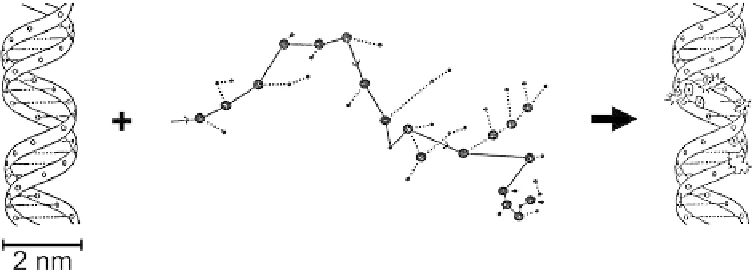Biology Reference
In-Depth Information
day.
1
e
3.
Naturally occurring DSBs can arise by several
mechanisms and pathways that are often similar or
identical to those that give rise to DSBs induced by
external sources.
abasic sites within nucleosome cores are destabilized by
lysine residues in the N-terminal region of histone H4,
and bistranded abasic site lesions are rapidly converted
to DSBs.
14
In contrast, naturally produced hydroxyl
radicals are considerably more dispersed and generate
far fewer DSBs. Nonetheless, unrejoined SSBs probably
lead to
Reactive Oxygen Species and Ionizing Radiation
Mitochondria convert between 0.1 and 1% of cellular
oxygen to superoxide, O
2
e
, during normal respiration.
4
Mitochondrial and cytosolic superoxide dismutases
can in turn convert the superoxide to hydrogen
peroxide. However, Fenton chemistry of hydrogen
peroxide with metal ions, particularly Fe
2
þ
, generates
hydroxyl-free radicals,
OH, and these highly reactive
free radicals can react with DNA bases and deoxyribose
groups, through addition to double bonds or hydrogen-
atom abstraction, to form base lesions, such as thymine
glycol and 8-oxoguanine, and DNA single-strand breaks
(SSBs).
5
e
7
Similar DNA damage can arise from reaction
with peroxynitrite (ONO2
) produced by macrophages
to combat infection.
5
e
7
Hydroxyl free radicals are also
the major DNA reactive species generated by radiolysis
of water and are responsible for most of the base damage
and strand breaks produced by X-rays and gamma-
rays.
6
An important difference, however, between
endogenously generated free radicals and those
produced by IR is their distribution. The deposition of
energy along the radiation track leads to the clustered
production of free radicals, and thus provides the oppor-
tunity for the formation of complex lesions composed of
more than one damaged DNA component (base
damage, base loss or strand break) within one or two
helical turns of DNA (
Figure 8.1
).
8
e
10
Mathematical
models of radiation track structure indicate that
25
e
30% of radiation-induced lesions are of a complex
nature.
11
Direct DSBs constitute one type of complex
lesion and the ratio of radiation-induced DSBs to SSBs
is ~1:25. In addition, other complex lesions can be con-
verted to DSBs in the course of repair.
12,13
Furthermore,
the
formation of DSBs during DNA
replication.
15
e
18
An important feature of the DSBs generated by
oxidative damage is the chemical nature of the
strand-break termini, which is dictated by the site of
reaction on the deoxyribose moiety,
6,19,20
particularly
the 3
0
,4
0
,and5
0
-carbon atoms, and the presence or
absence of oxygen.
21
Among the end groups found at
strand breaks produced by IR are 3
0
-phosphoglycolal-
dehyde, arising from attack at the 3
0
-carbon atom, 3
0
-
phosphoglycolate (attack at the 4
0
-carbon atom) and
3
0
-phosphate (attack at the 5
0
-carbon atom) (
Figure 8.2
).
The production of 3
0
-phosphoglycolate, unlike 3
0
-
phosphate, appears to be dependent on the presence
of oxygen or nitroaromatic radiosensitizers.
21
The
major 5
0
-end group found with model systems is
5
0
-phosphate and, to a lesser extent, a 5
0
-aldehyde.
20
Analysis of DNA in irradiated thymocytes indicated
the production of 5
0
-hydroxyl end groups at ~15%
of the termini.
22,23
Since DNA ligation requires 3
0
-
hydroxyl and 5
0
-phosphate termini, the presence of
any other end group will necessitate processing of the
termini prior to ligation.
Bleomycin and Enediyne Antibiotics
These anticancer agents represent a diverse group of
compounds that act in a similar fashion to radiation to
cleave DNA and, therefore, are often referred to as
“radiomimetic” drugs. They are noted for their capacity
to generate a high proportion of DSBs and other bi-
stranded lesions.
24
Bleomycin has been used as a cancer
chemotherapeutic agent for more than thirty years and
FIGURE 8.1
Clustered lesions generated by IR. Model of clustered DNA damage induced by a low-energy electron track generated by
superimposing a simulation of the electron track onto a segment of DNA drawn to the same scale. Low-energy electrons are produced by
g
-rays
and X-rays. In the track structure large circles represent ionizations and small circles excitations. Strand breaks are indicated by broken ribbons
and damaged bases by X.
From Goodhead, 1994.
9


